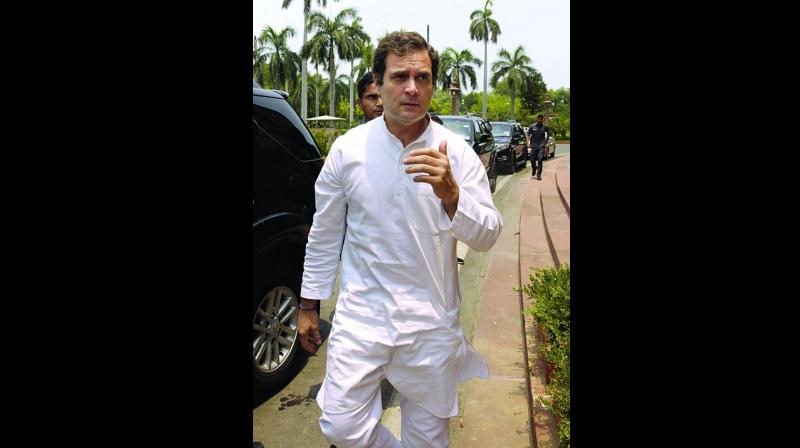Pivot of Cong renewal: Inner-party democracy
Sonia Gandhi, back then, did not accept responsibility for the defeat despite the universal law of accountability beginning at the top.;

The 2019 Lok Sabha election is not the first instance of the Congress Party being pushed into a crisis. Of varying severities, the party was previously confronted with post-poll challenges, unprecedented on each occasion, in 1967, 1977, 1989, 1996, 1999 and 2014. While crises in previous years can be left for later evaluation, the tight spot the party found itself after the 2014 polls and developments within the party after that defeat must be recalled amid abundance of opinion that the Congress is heading for a meltdown.
To get a perspective on the Congress leadership's response then and now, it is important to recall events after the 2014 debacle. Neither did the Congress president, Sonia Gandhi take its blame, nor did Manmohan Singh, who was Prime Minister. The two of them were jointly responsible for frittering away the gains of 2009 when the Congress became the first party since 1991 to win more than 200 seats in Lok Sabha. Instead, the president formed a four-member committee headed by A.K. Antony and comprising loyalists to review the party's loss. The report was finalised in a few months and targeted everything from infighting, demoralisation of workers, lack of effective pre-poll alliances, corruption and communal polarisation. However, it made no reference to the leadership’s inability or failure to target these shortcomings.
Sonia Gandhi, back then, did not accept responsibility for the defeat despite the universal law of accountability beginning at the top. In contrast, Rahul Gandhi has acted bravely and as per the democratic tradition of the leader taking the blame for failure, quit as party president. It must be kept in mind that Rahul Gandhi faced a bigger challenge than his mother because Prime Minister Narendra Modi contested the election with the advantage of the entire state machinery backing every action of his, sometimes in a grossly unfair manner. Despite this, Rahul Gandhi was not exactly a pushover as an Opposition leader and Mr Modi’s exertions against the Congress president was testimony to this till the post-Pulwama/Balakot events altered the poll narrative.
Having said that his decision to resign was democratic, it also reveals two other sets of reality. First, Rahul Gandhi’s was essentially a ploy to force other leaders, especially some of the veterans —two of them, Kamal Nath and Ashok Gehlot, were reportedly mentioned by him at a party meeting — to also accept their share of responsibility and step down from their offices. Secondly, and this stems from the first point, use of a tactic to get some of these party veterans to step down is proof that despite having been Congress president since December 2017, Rahul Gandhi's writ did not run in the party as forcefully as his mother’s did when she was party chief. Given this backdrop, he had little option but to either trigger an upheaval within the party or allow matters to be brushed beneath the carpet again. Without doubt, Rahul chose the first option in the hope that uncertainty for the moment, even lasting several months, will be beneficial in the long run.
In almost another 10 days it will be two months since Rahul Gandhi resigned as party president and unless his colleagues get together to evolve a different arrangement, it will soon be 20 months and there may be little left for the party to consolidate. Already, the malady of greed for power is propelling desertions from the party in Karnataka and Goa. In coming weeks, expect more leaders with little commitment, save to themselves, crossing over to the BJP. The process for creating a new structure in the Congress must begin post-haste and new leaders must move into leadership positions. It would defeat the entire purpose of Rahul Gandhi’s effort if just an interim arrangement is made by appointing a loyal veteran as party president and then the arrangement is allowed to continue indefinitely. Despite opposition from sections of old-timers, the process for electing a new president must be set in motion. The selection process must be transparent and take away the charge of the Congress being a dynastic party run on undemocratic lines. In fact, the Congress has a great opportunity to display inner-party democracy at a time when its primary rival, the BJP, has increasingly become a collective of a few.
Rahul Gandhi has to ensure that the new leader of the party is never seen as a modern day “Bharat” who is keeping the seat warm for the eventual return of “Ram”. He must ensure that the new chief has complete independence and authority while adhering to democratic principles of functioning. Crucial to this would be the position of the “three Gandhis” under the new chief. None of them — Sonia, Rahul or Priyanka Gandhi Vadra — can be seen as the first among equals. On the face of this, this may be a difficult task given the fact that Rahul Gandhi or the others in the family still have comparatively greater popularity among people than other leaders.
This provides the Congress with the opportunity to separate the position of the party president from its legislative head. The party has got an opportunity to achieve what was originally intended: that the party president should not be the Prime Minister when the party is in power and must not be the leader of the party’s legislature party when in opposition. Till a new leader emerges on the horizon, Rahul Gandhi remains the primary vote catcher of the party and he must be utilised to lead the Opposition in Parliament and the campaign among people. Not just the Gandhis and the Congress party, but even the country requires a “new look” in the organisation which can no longer bask in the glory of its past. After all, if there is no Opposition, India will stop being a democracy.

